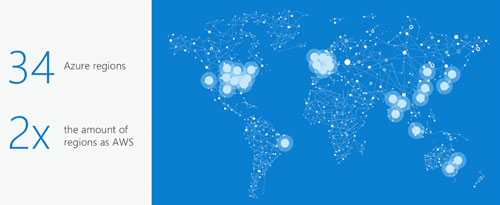Microsoft Azure Footprint Approaching 3 Dozen Regions
Microsoft this week at its Ignite show in Atlanta unveiled several new regions for the Azure public cloud, opening its first two regions in privacy-conscious Germany and pinpointing plans for four more regions around the world.
Microsoft Azure is the second-largest global public cloud by customer revenues, according to independent analyst estimates, and Microsoft now claims an Azure presence in twice as many regions as the public cloud market-leading Amazon Web Services (AWS).
"Over the last several years we've been hard at work expanding it to run literally all over the world," said Scott Guthrie, executive vice president for the Microsoft Cloud and Enterprise Group, in an Ignite keynote Monday. "We now have 34 unique Azure regions around the world."
Guthrie described Azure regions as clusters of multiple datacenters that are geographically close to customers to allow them to access data and computing power faster.
 [Click on image for larger view.] Guthrie's keynote included this slide showing Microsoft's Azure regions worldwide.
[Click on image for larger view.] Guthrie's keynote included this slide showing Microsoft's Azure regions worldwide.
The list includes 30 generally available regions, including a pair that just opened in Germany, where Microsoft previously didn't have a presence.
"The Microsoft Cloud is also the only [global] cloud vendor licensed to operate legally in China, and the only to offer full data sovereignty in Germany, using our data trustee model," Guthrie said.
To meet German data sovereignty requirements, data in the new regions in Frankfurt and Magdeburg will be under the control of T-Systems, a Deutsche Telekom company acting as the German data trustee. Those new datacenters bring Microsoft's European Azure region list to six, joining Ireland, the Netherlands, Cardiff and London.
Guthrie's total of 34 also includes four regions that are in the development stage but are not yet online. Those are a U.S. Department of Defense East and a U.S. Department of Defense West, as well as two regions in South Korea.
Amazon categorizes its public cloud AWS infrastructure differently and, like Microsoft, positions its datacenter coverage in a light favorable to the physical investments the company has made. While it currently lists 13 regions worldwide with four more in the works, Amazon can make a case that the 35 entities within those regions that it calls availability zones are similar in some ways to what Microsoft calls regions. Although Azure currently has a regional presence in 12 countries, AWS is close behind in 10. Both Microsoft and Amazon detail the global scope of their datacenter infrastructure here for Azure and here for AWS.
Posted by Scott Bekker on September 27, 2016